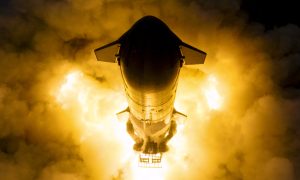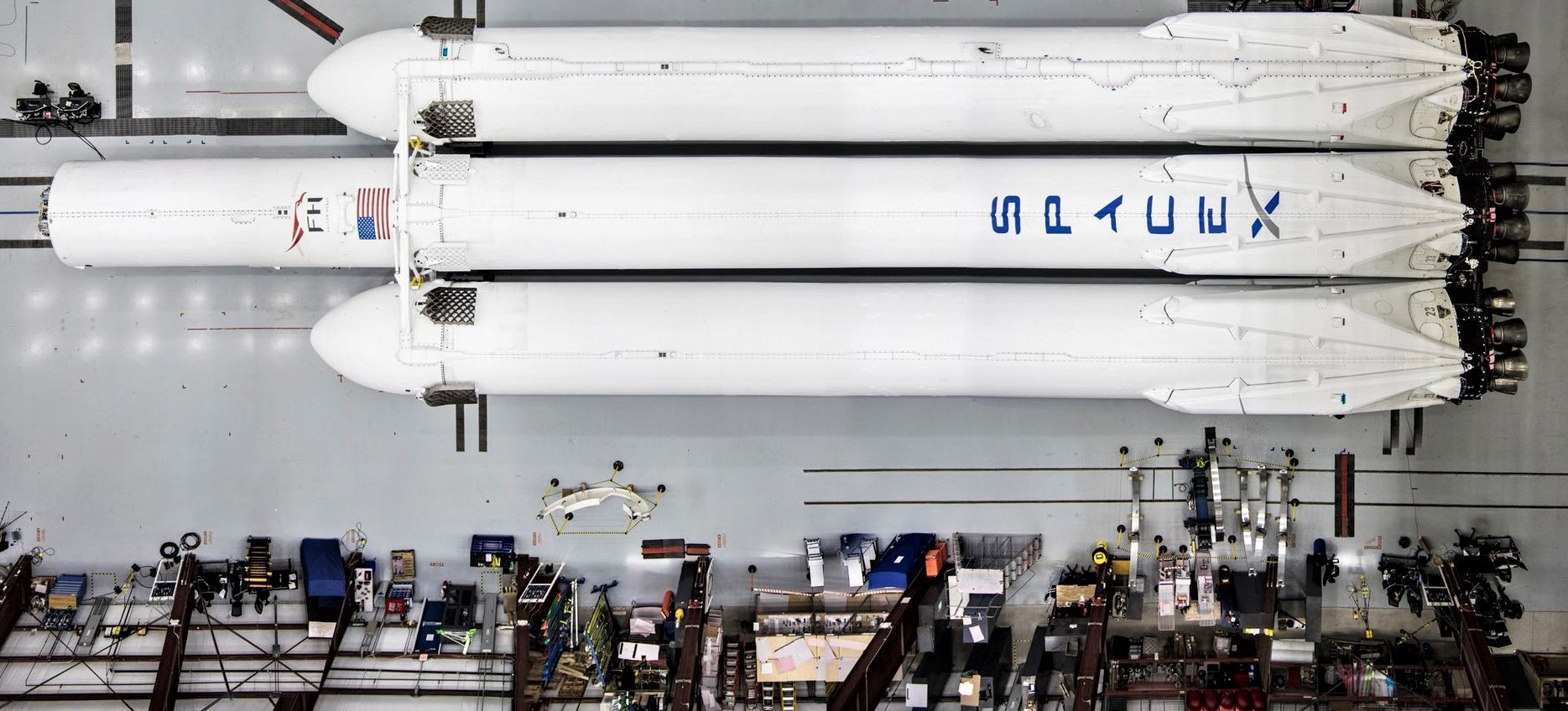

SpaceX
SpaceX’s April 7th Falcon Heavy launch a step toward new commercial markets
A bit less than 14 months after SpaceX’s Falcon Heavy took to the sky for the first time, the company’s super-heavy-lift rocket – the only such vehicle in the world that is currently operational – has garnered a pending date for its second launch attempt and commercial debut.
While there is some inherent uncertainty surrounding the (once again) fairly new rocket, SpaceX has now officially filed a plan with the Cape Canaveral range authorities that would see Falcon Heavy nominally conduct a critical static fire test as soon as March 31st, followed one week later by a launch target of no earlier than (NET) 6:36 pm EDT (22:36 UTC), April 7th. Set to place the ~6000 kg (13,200 lb) Arabsat 6A communications satellite in a high-energy geostationary orbit, a successful mission that ultimately proves Falcon Heavy’s commercial utility could also raise global launch market interest in the rocket, including potential anchor customers like NASA.
Falcon Heavy enters a different era
While it could be fairly argued that SpaceX has already near-flawlessly demonstrated Falcon Heavy’s performance and basic existence with the rocket’s February 2018 launch debut, that debut is really only half the story when it comes to breaking into commercial markets as a serious contender. Above all else, the fact remains that Falcon Heavy is often seen as infamous for what is perceived as a torturous, delay-ridden period of development, a common partial misunderstanding that has not exactly been combated by the now 14+ months separating the rocket’s first and second launch attempts. In the industries that have the most potential interest in Falcon Heavy, on-time launches are a central selling point of launch vehicles, with affordability effectively being a luxury behind timeliness and overall reliability.
Despite the success of Falcon Heavy’s debut, what SpaceX has not yet demonstrated is the ability to reliably and accurately insert a large customer payload into a specific orbit, for a specific (i.e. contracted) price. Adding another partial hurdle to the path before Falcon Heavy, the rocket’s first launch featured a hardware setup that could be described as a one-off, owing to the fact that Flight 1 utilized a mishmash of flight-proven Block 2 boosters and one unique Block 3-derived center core. By the time that the rocket was ready for its first launch, SpaceX was just three months away from debuting Falcon 9’s Block 5 variation, framed as the family’s ‘final’ version. Featuring an extensive range of major changes to Falcon structures, Merlin engines, avionics, reusability, and manufacturing processes, this ultimately meant that the next Falcon Heavy to fly would be a significantly different rocket compared to its sole predecessor.

While we actually know very little about what the task of re-certifying Falcon Heavy’s Block 5 upgrade for flight entailed, the minimum of 14 months separating flights 1 and 2 offers at least a partial idea of just how extensive the required rework was. With a long-delayed customer’s extremely expensive (likely $150-300M+) satellite on the line, there is a surplus of pressure on SpaceX to both complete this launch flawlessly and do so as soon as possible.
If all goes well with the imminent launch of Arabsat 6A and the USAF’s STP-2 mission shortly thereafter, SpaceX will have done a great deal to assuage many industry doubts about Falcon Heavy, particularly its practical launch availability and the company’s ability to ensure that its launches are at least roughly on-time. As of today, SpaceX has won five firm launch contracts for Falcon Heavy – three in the last year alone – and has the potential to acquire several additional contracts in the coming years, ranging from additional national security satellites from the NRO and USAF to flagship NASA science missions like the Jupiter-bound Europa Clipper. Aside from Blue Origin’s New Glenn (launch debut NET 2021), ULA’s Vulcan (also NET 2021), and ULA’s Delta IV Heavy (likely far too expensive), SpaceX’s Falcon Heavy is also the frontrunner for commercial contracts to launch segments of a proposed lunar space station, with launches potentially beginning as early as the early 2020s.
Further still, NASA administrator Jim Bridenstine announced earlier this month that the space agency was actively considering a stand-in fix for
Either way, the long term prospects of Falcon Heavy rocket could potentially be both lucrative for SpaceX and immensely beneficial for satellite industries and national space agencies alike. If SpaceX can demonstrate that it has inherited Falcon 9’s now thoroughly impressive reliability and moderate to great schedule assurance, the market for Falcon Heavy could end up supporting a major fraction of SpaceX’s sizable launch business.

Check out Teslarati’s Marketplace! We offer Tesla accessories, including for the Tesla Cybertruck and Tesla Model 3.
News
SpaceX launches Ax-4 mission to the ISS with international crew
The SpaceX Falcon 9 launched Axiom’s Ax-4 mission to ISS. Ax-4 crew will conduct 60+ science experiments during a 14-day stay on the ISS.

SpaceX launched the Falcon 9 rocket kickstarting Axiom Space’s Ax-4 mission to the International Space Station (ISS). Axiom’s Ax-4 mission is led by a historic international crew and lifted off from Kennedy Space Center’s Launch Complex 39A at 2:31 a.m. ET on June 25, 2025.
The Ax-4 crew is set to dock with the ISS around 7 a.m. ET on Thursday, June 26, 2025. Axiom Space, a Houston-based commercial space company, coordinated the mission with SpaceX for transportation and NASA for ISS access, with support from the European Space Agency and the astronauts’ governments.
The Ax-4 mission marks a milestone in global space collaboration. The Ax-4 crew, commanded by U.S. astronaut Peggy Whitson, includes Shubhanshu Shukla from India as the pilot, alongside mission specialists Sławosz Uznański-Wiśniewski from Poland and Tibor Kapu from Hungary.
“The trip marks the return to human spaceflight for those countries — their first government-sponsored flights in more than 40 years,” Axiom noted.
Shukla’s participation aligns with India’s Gaganyaan program planned for 2027. He is the first Indian astronaut to visit the ISS since Rakesh Sharma in 1984.
Axiom’s Ax-4 mission marks SpaceX’s 18th human spaceflight. The mission employs a Crew Dragon capsule atop a Falcon 9 rocket, designed with a launch escape system and “two-fault tolerant” for enhanced safety. The Axiom mission faced a few delays due to weather, a Falcon 9 leak, and an ISS Zvezda module leak investigation by NASA and Roscosmos before the recent successful launch.
As the crew prepares to execute its scientific objectives, SpaceX’s Ax-4 mission paves the way for a new era of inclusive space research, inspiring future generations and solidifying collaborative ties in the cosmos. During the Ax-4 crew’s 14-day stay in the ISS, the astronauts will conduct nearly 60 experiments.
“We’ll be conducting research that spans biology, material, and physical sciences as well as technology demonstrations,” said Whitson. “We’ll also be engaging with students around the world, sharing our experience and inspiring the next generation of explorers.”
SpaceX’s Ax-4 mission highlights Axiom’s role in advancing commercial spaceflight and fostering international partnerships. The mission strengthens global space exploration efforts by enabling historic spaceflight returns for India, Poland, and Hungary.
News
Starlink Cellular’s T-Mobile service to grow with third-party app data
From Oct 2025, T-Satellite will enable third-party apps in dead zones! WhatsApp, X, AccuWeather + more coming soon.
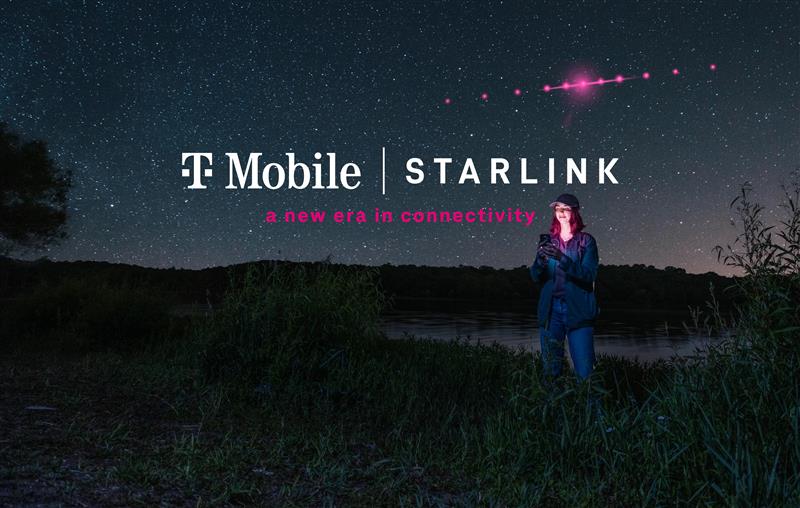
Starlink Cellular’s T-Mobile service will expand with third-party app data support starting in October, enhancing connectivity in cellular dead zones.
T-Mobile’s T-Satellite, supported by Starlink, launches officially on July 23. Following its launch, T-Mobile’s Starlink Cellular service will enable data access for third-party apps like WhatsApp, X, Google, Apple, AccuWeather, and AllTrails on October 1, 2025.
T-Mobile’s Starlink Cellular is currently in free beta. T-Satellite will add MMS support for Android phones on July 23, with iPhone support to follow. MMS support allows users to send images and audio clips alongside texts. By October, T-Mobile will extend emergency texting to all mobile users with compatible phones, beyond just T-Mobile customers, building on its existing 911 texting capability. The carrier also provides developer tools to help app makers integrate their software with T-Satellite’s data service, with plans to grow the supported app list.
T-Mobile announced these updates during an event celebrating an Ookla award naming it the best U.S. phone network, a remarkable turnaround from its last-place ranking a decade ago.
“We not only dream about going from worst to best, we actually do it. We’re a good two years ahead of Verizon and AT&T, and I believe that lead is going to grow,” said T-Mobile’s Chief Operating Officer Srini Gopalan.
T-Mobile unveiled two promotions for its Starlink Cellular services to attract new subscribers. A free DoorDash DashPass membership, valued at $10/month, will be included with popular plans like Experience Beyond and Experience More, offering reduced delivery and service fees. Meanwhile, the Easy Upgrade promotion targets Verizon customers by paying off their phone balances and providing flagship devices like the iPhone 16, Galaxy S25, or Pixel 9.
T-Mobile’s collaboration with SpaceX’s Starlink Cellular leverages orbiting satellites to deliver connectivity where traditional networks fail, particularly in remote areas. Supporting third-party apps underscores T-Mobile’s commitment to enhancing user experiences through innovative partnerships. As T-Satellite’s capabilities grow, including broader app integration and emergency access, T-Mobile is poised to strengthen its lead in the U.S. wireless market.
By combining Starlink’s satellite technology with strategic promotions, T-Mobile is redefining mobile connectivity. The upcoming third-party app data support and official T-Satellite launch mark a significant step toward seamless communication, positioning T-Mobile as a trailblazer in next-generation wireless services.
News
Starlink expansion into Vietnam targets the healthcare sector
Starlink aims to deliver reliable internet to Vietnam’s remote clinics, enabling telehealth and data sharing.

SpaceX’s Starlink expansion into Vietnam targets its healthcare sector. Through Starlink, SpaceX seeks to drive digital transformation in Vietnam.
On June 18, a SpaceX delegation met with Vietnam’s Ministry of Health (MoH) in Hanoi. SpaceX’s delegation was led by Andrew Matlock, Director of Enterprise Sales, and the discussions focused on enhancing connectivity for hospitals and clinics in Vietnam’s remote areas.
Deputy Minister of Health (MoH) Tran Van Thuan emphasized collaboration between SpaceX and Vietnam. Tran stated: “SpaceX should cooperate with the MoH to ensure all hospitals and clinics in remote areas are connected to the StarLink satellite system and share information, plans, and the issues discussed by members of the MoH. The ministry is also ready to provide information and send staff to work with the corporation.”
The MoH assigned its Department of Science, Technology, and Training to work with SpaceX. Starlink Vietnam will also receive support from Vietnam’s Department of International Cooperation. Starlink Vietnam’s agenda includes improving internet connectivity for remote healthcare facilities, developing digital infrastructure for health examinations and remote consultations, and enhancing operational systems.
Vietnam’s health sector is prioritizing IT and digital transformation, focusing on electronic health records, data centers, and remote medical services. However, challenges persist in deploying IT solutions in remote regions, prompting Vietnam to seek partnerships like SpaceX’s.
SpaceX’s Starlink has a proven track record in healthcare. In Rwanda, its services supported 40 health centers, earning praise for improving operations. Similarly, Starlink enabled remote consultations at the UAE’s Emirati field hospital in Gaza, streamlining communication for complex medical cases. These successes highlight Starlink’s potential to transform Vietnam’s healthcare landscape.
On May 20, SpaceX met with Vietnam’s Ministry of Industry and Trade, announcing a $1.5 billion investment to provide broadband internet, particularly in remote, border, and island areas. The first phase includes building 10-15 ground stations across the country. This infrastructure will support Starlink’s healthcare initiatives by ensuring reliable connectivity.
Starlink’s expansion in Vietnam aligns with the country’s push for digital transformation, as outlined by the MoH. By leveraging its satellite internet expertise, SpaceX aims to bridge connectivity gaps, enabling advanced healthcare services in underserved regions. This collaboration could redefine Vietnam’s healthcare infrastructure, positioning Starlink as a key player in the nation’s digital future.
-

 Elon Musk1 day ago
Elon Musk1 day agoTesla investors will be shocked by Jim Cramer’s latest assessment
-

 News6 days ago
News6 days agoTesla Robotaxi’s biggest challenge seems to be this one thing
-

 News2 weeks ago
News2 weeks agoTesla’s Grok integration will be more realistic with this cool feature
-

 Elon Musk2 weeks ago
Elon Musk2 weeks agoElon Musk slams Bloomberg’s shocking xAI cash burn claims
-
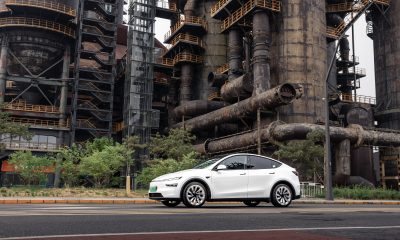
 News2 weeks ago
News2 weeks agoTesla China roars back with highest vehicle registrations this Q2 so far
-

 News2 weeks ago
News2 weeks agoTexas lawmakers urge Tesla to delay Austin robotaxi launch to September
-

 News2 weeks ago
News2 weeks agoTesla dominates Cars.com’s Made in America Index with clean sweep
-
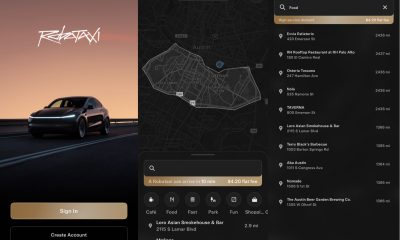
 Elon Musk1 week ago
Elon Musk1 week agoFirst Look at Tesla’s Robotaxi App: features, design, and more










